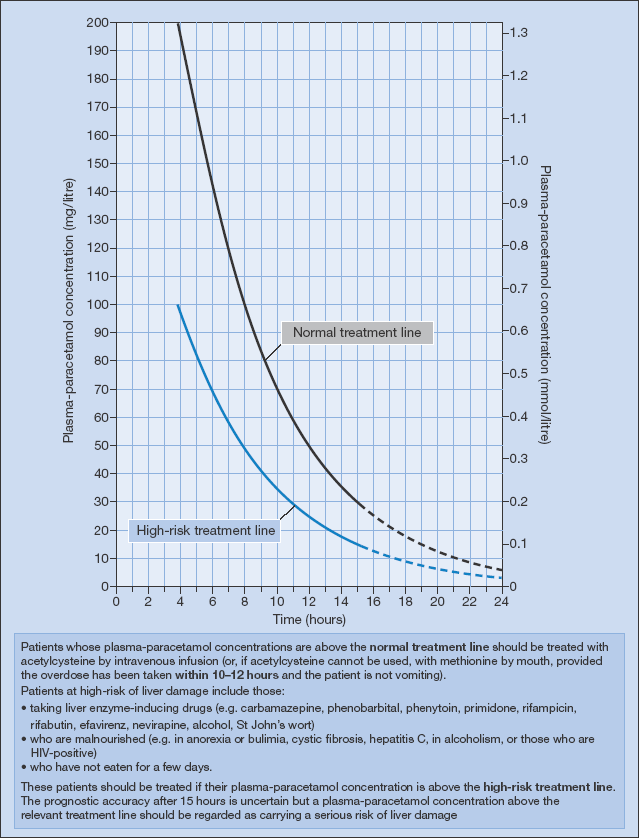Deliberate self-administration of drugs/substances with a view to causing harm or even death presents a major challenge not only in terms of dealing with the physical consequences of exposure to one or more toxins, but also with respect to addressing underlying psychosocial issues. Clinicians involved in the management of these complex cases need to adopt a holistic approach – ensuring that the patient comes to no/minimal physical harm is only the first step in management, and additional psychological/ongoing support to minimise the risk of further similar episodes is almost always required.
Not all episodes of poisoning are immediately self-evident, and it is important to keep an open mind when assessing patients for whom the immediate cause of their presentation is unclear. Clues that should alert you to a possible case of poisoning include: current/past history of depression/psychiatric illness; previous history of overdose/self-harm; history of excess alcohol consumption; social isolation/difficulties; needle marks; empty packets of drugs brought in by relatives/paramedics; admission from a workplace/environment where potential toxins are present.
Clinical Presentation
Many patients who take drug overdoses are still conscious when seen and will often state which tablets they have taken and/or bring the bottle(s)/packet(s) with them. If unconscious, then other causes of coma must also be considered even if an overdose is suspected, e.g. is the patient known to have diabetes (exclude hypoglycaemia) or be steroid-dependent (check for steroid card or alert bracelet)? Is there any evidence of a head injury? Relatives or friends may know whether the patient is currently under active medical treatment. Patients often take more than one drug and very often alcohol in addition.
As always, a good history and careful physical examination are central both to establishing the extent to which the patient has suffered adverse effects in cases of known poisoning and to providing clues as to possible aetiological factors in suspected cases/where the agent is unknown. Figure 22.1 correlates clinical findings with specific poisons, although it is important to note that in the early stages clinical signs may be limited, while mixed overdoses can be associated with overlapping features.
Typical features of commonly encountered drug overdoses involving prescription/over-the-counter (OTC) medications are shown in Table 22.2, and those resulting from use of ‘recreational’ drugs and/or alcohol/ethanol in Table 22.3.
Table 22.2 Clinical Features and Specific Investigations/Management for overdoses Involving Prescription/over-the-counter Drugs
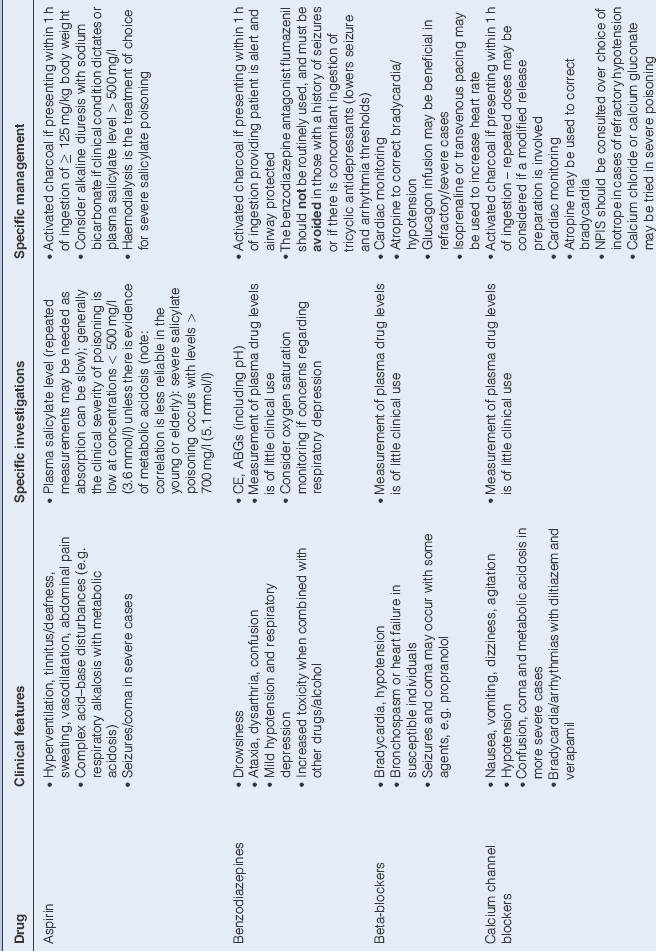
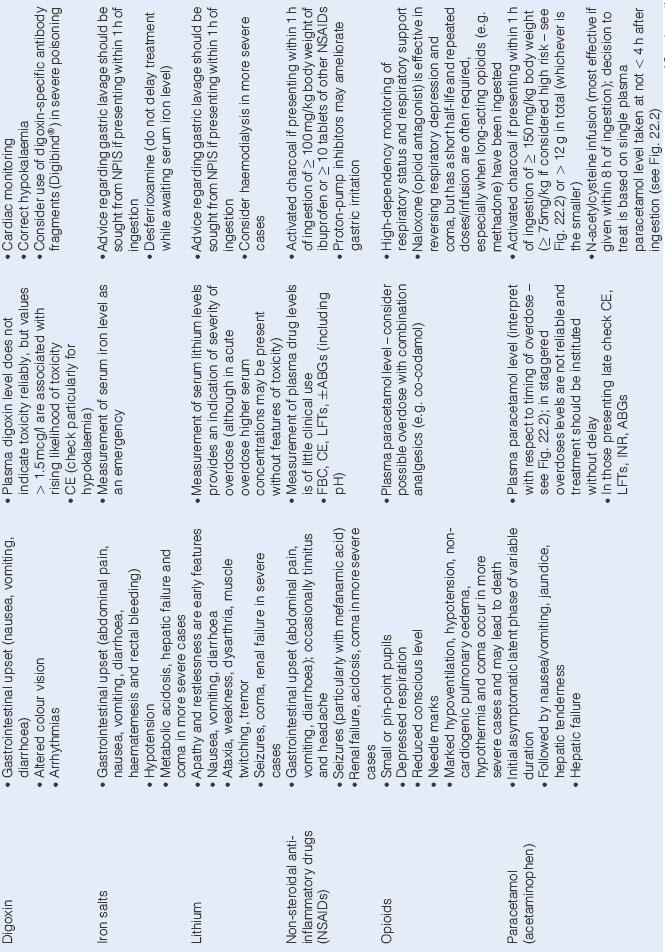
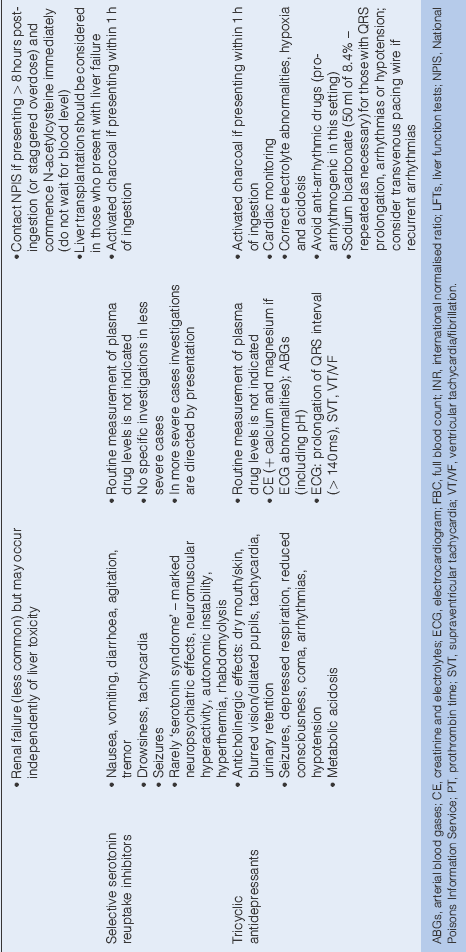
Table 22.3 Clinical Features and Specific Investigations/Management for Overdoses Involving Alcohol and other ‘Recreational’ Drugs
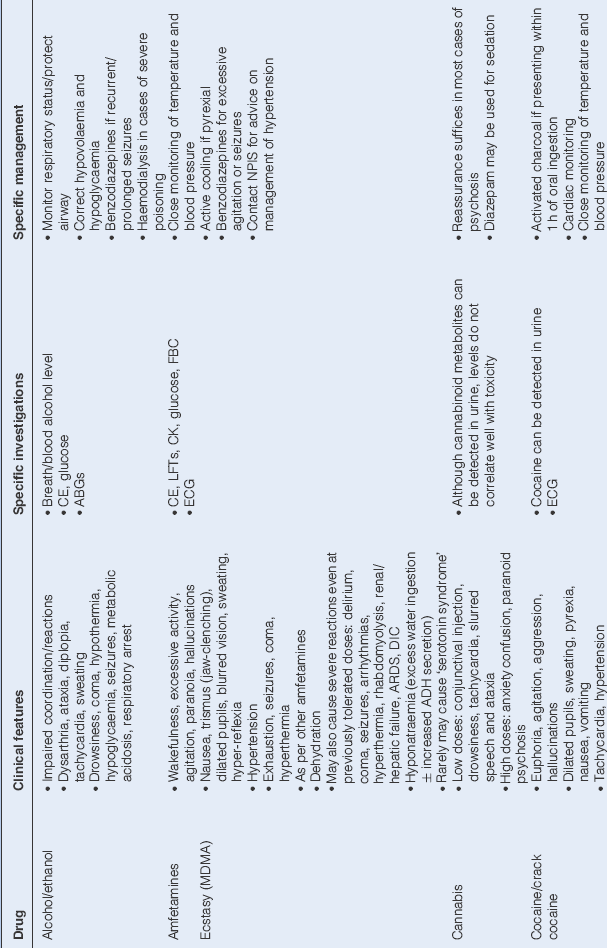

Management
General Measures
All patients with suspected poisoning should be admitted to hospital for further assessment/monitoring. Symptomatic treatment and supportive measures will suffice in most cases, but specific antidotes may be required.
Begin with an assessment of:
- Airway
- Breathing
- Circulation
Cardiorespiratory Dysfunction
Ventilatory support and optimisation of cardiac function/blood pressure should be provided where necessary in accordance with standard management guidelines/protocols for patients with cardiorespiratory depression. Patients with a reduced conscious level must be monitored in a high-dependency/intensive care setting.
Nausea/Vomiting
Vomiting is a common side effect of poisoning and usually responds to anti-emetics.
Agitation
Simple reassurance and support and nursing in a quiet environment will suffice in most cases. Always exclude other possible treatable causes (e.g. hypoxia, hypotension, hypoglycaemia) before considering the use of sedatives. Where required, short-acting agents (e.g. diazepam) are preferred with appropriate monitoring.
Seizures
Single short-lived convulsions do not require treatment – but check that there is no other reversible cause (e.g. hypoglycaemia, electrolyte disturbance). Persistent or recurrent seizures should be treated with lorazepam or diazepam and the patient transferred to a high-dependency/intensive care setting.
Temperature Dysregulation
Hypothermia may develop in any patient with a reduced conscious level, especially if cold-exposed. Active warming measures can be used to raise the temperature in a controlled manner, with cardiac monitoring for arrhythmias.
Hyperthermia may occur in patients taking CNS stimulants. Removal of excess clothing, use of a fan and sponging with tepid water may help. In cases of severe hyperthermia check with the National Poisons Information Service (see below) for advice on specific measures.
Psychiatric Assessment
Once the physical consequences of poisoning have been prevented/treated, formal psychiatric evaluation is required in all cases of suspected self-harm. For patients deemed to be at high risk of further self-harm/suicidal intent, consider special (one-to-one) nursing while medical management is completed and psychiatric review awaited.
Specific Measures
UK National poisons information service and TOXBASE
Specialist information and advice on the management of suspected/confirmed cases of poisoning is available 24 h a day from the UK National Poisons Information Service (NPIS). If in doubt, seek early help. TOXBASE is the primary clinical toxicology database of NPIS and is available online to registered users at www.toxbase.org. It provides a wealth of information about diagnosis, investigation and treatment of patients who have been exposed to drugs, household products and industrial/agricultural chemicals.
Preventing Absorption and Enhancing Elimination of Ingested Toxins
Gastric Lavage
This is rarely required and is of limited value if performed more than 1 h after ingestion. Its use should be reserved for substances that cannot be effectively removed by other means (e.g. iron, lithium), and only if a life-threatening amount has been ingested within the previous hour. It must only be undertaken if the airway is adequately protected/secured, and should not be used if a corrosive substance has been swallowed. It is advisable to check with NPIS/TOXBASE if considering gastric lavage.
Activated Charcoal
Given by mouth, activated charcoal (50 g in an adolescent/adult; children 1 g/kg) can bind many drugs/poisons in the gastrointestinal tract, thereby reducing their absorption. It should be given as soon as possible and confers benefits up to 1 h after ingestion, and occasionally longer if dealing with modified release preparations. Repeated doses may be required for certain toxins whose elimination is aided even after they have been absorbed (e.g. carbamazepine, quinine, theophylline).
Certain substances (acids, alkalis, metals/metallic salts (e.g. mercury, iron, lithium), methanol, ethylene glycol) are not bound by activated charcoal – if in doubt, check with NPIS/TOXBASE.
Alkaline Diuresis and Dialysis
Alkalinisation of the urine (pH 7.5–8.5) may aid elimination of salicylates. It should be undertaken in a high-dependency/intensive care setting.
Haemodialysis is generally reserved for patients who have ingested significant amounts of a toxin with a low volume of distribution/weak protein binding, e.g. salicylates, lithium, methanol, ethylene glycol.
Specific Toxins
Specific antidotes are available for a small number of toxins and can be life-saving (e.g. N-acetylcysteine in paracetamol overdose) (Fig. 22.2). In addition, complications associated with certain poisons benefit from targeted therapies (e.g. use of sodium bicarbonate to treat arrhythmias caused by tricyclic antidepressant overdose), while in other cases avoidance of certain classes of drug is recommended to avoid exacerbating the situtation (e.g. anti-arrhythmics in tricyclic antidepressant overdose). Tables 22.2 and 22.3 outline specific investigations and management measures for poisoning associated with prescription/over-the-counter medications (Table 22.2) and alcohol/‘recreational’ drugs (Table 22.3). For more detailed information on a broader range of toxins consult NPIS/TOXBASE.
Figure 22.2 Algorithm for management of paracetamol overdose. Reproduced with permission from University of Wales College of Medicine Therapeutics and Toxicology Centre.

Stay updated, free articles. Join our Telegram channel

Full access? Get Clinical Tree


